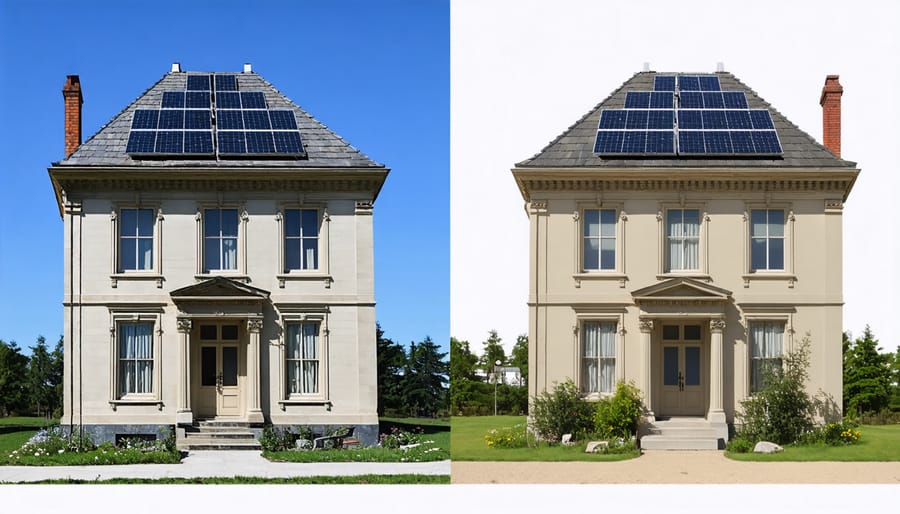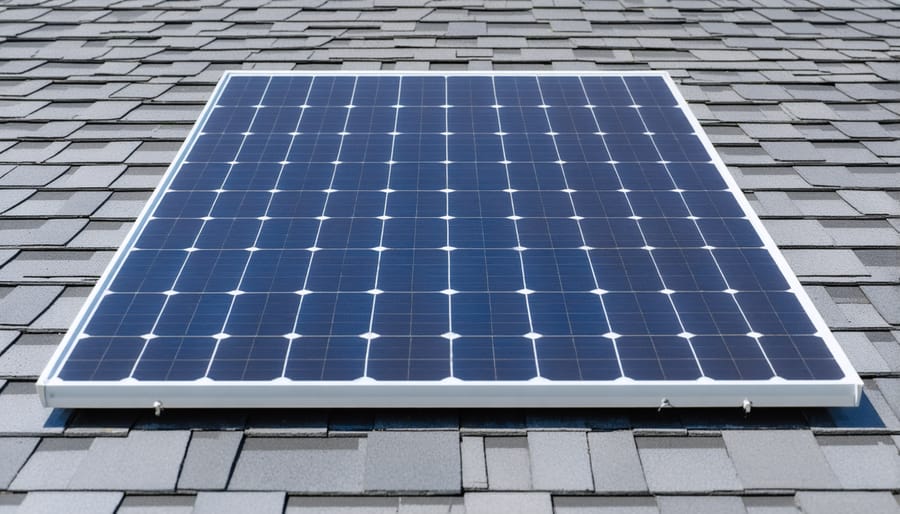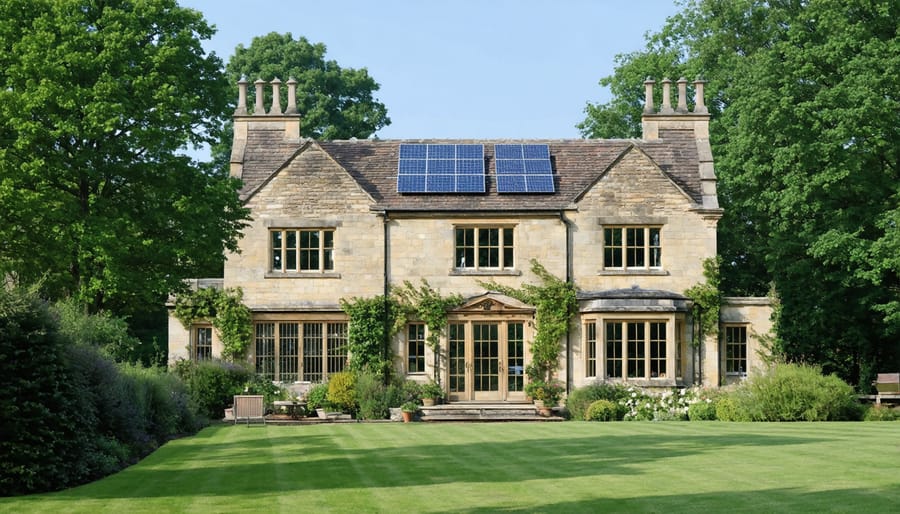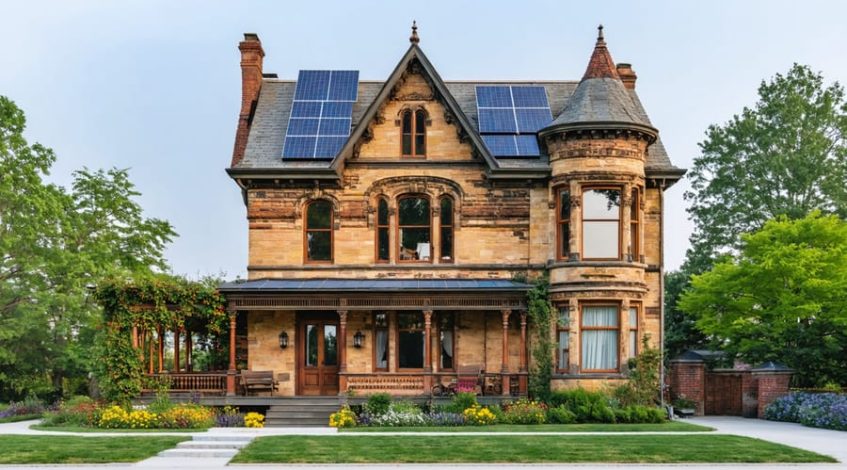Transform aging buildings into sustainable powerhouses while preserving historic buildings with solar technology. Modern solar integration delivers up to 30% energy cost reduction without compromising architectural integrity. Property managers across Europe and North America have successfully retrofitted historic structures by utilizing low-profile panels, innovative mounting systems, and specialized installation techniques that meet preservation guidelines.
The $369 billion Inflation Reduction Act now provides substantial tax incentives for solar installations on historic properties, covering up to 30% of project costs. Leading preservation architects have developed precise methodologies for maintaining period aesthetics while incorporating renewable energy systems, resulting in projects that enhance property value while reducing carbon footprints.
Industry data shows that carefully planned solar installations on historic buildings achieve ROI within 5-7 years while meeting strict preservation standards. Forward-thinking facility managers are leveraging these proven approaches to balance heritage conservation with modern energy efficiency, creating sustainable landmarks for future generations.
Navigating Heritage Regulations for Solar Installation
Key Preservation Standards
When installing solar systems on historic buildings, adherence to key preservation standards is essential for maintaining architectural integrity while embracing renewable energy solutions. The Secretary of the Interior’s Standards for Rehabilitation serves as the primary framework, requiring that solar installations remain reversible and minimize visual impact on historic features.
Compliance measures typically include ensuring solar panels are not visible from primary public viewing areas, maintaining appropriate setbacks from roof edges, and using mounting systems that avoid permanent alterations to historic materials. Installation teams must document existing conditions and employ non-invasive attachment methods that prevent damage to historic fabric.
Projects must preserve character-defining elements such as decorative cornices, slate roofing, and period-specific architectural details. Local historic preservation boards often require detailed documentation, including sight-line studies and installation plans that demonstrate minimal impact on the building’s historic character.
For successful implementation, property owners should engage preservation specialists early in the planning process and select solar contractors with documented experience in historic building installations. This collaborative approach ensures both energy efficiency goals and preservation requirements are met effectively.
Obtaining Necessary Approvals
Securing necessary approvals for solar installation requires a systematic approach through multiple regulatory channels. Begin by consulting your local building department to understand specific requirements and obtain building permits. Submit detailed architectural drawings, engineering plans, and equipment specifications as part of your application package.
For grid-connected systems, contact your utility company early in the process to secure interconnection agreements. These agreements typically require professional electrical diagrams and may necessitate system modifications to meet grid standards.
If your property is in a historic district or subject to preservation guidelines, submit applications to both the historic preservation board and architectural review board. Include visual renderings showing minimal impact on historic features, and prepare documentation demonstrating how the installation preserves the building’s character.
Environmental impact assessments may be required in certain jurisdictions. Work with certified environmental consultants to prepare these reports. Many municipalities also require structural engineering certifications to verify roof integrity and load-bearing capacity.
Maintain open communication with approval authorities throughout the process, and expect timeline variations depending on your location and project scope. Consider engaging a solar consultant familiar with local regulations to streamline the approval process.

Innovative Solar Solutions for Historic Buildings
Low-Profile Solar Systems
Low-profile solar systems offer an elegant solution for buildings where traditional panel installations might compromise architectural integrity. These innovative systems are particularly valuable for heritage site solar solutions, where maintaining historical character is paramount.
Modern solar tiles and thin-film panels can be integrated seamlessly into existing rooflines, matching traditional materials in both color and texture. These systems typically sit just inches above the roof surface, creating minimal visual impact while delivering substantial energy benefits. Some advanced options include solar shingles that replace conventional roofing materials entirely, providing both weather protection and power generation.
Building-integrated photovoltaics (BIPV) represent another sophisticated approach, incorporating solar technology directly into building materials like windows, facades, and skylights. These systems can achieve energy generation without any visible panels, making them ideal for projects where aesthetics are crucial.
Recent technological advances have also produced transparent and semi-transparent solar materials that can be incorporated into windows while maintaining natural light transmission. These solutions are particularly valuable for commercial buildings where window space is abundant but roof access may be limited.
For maximum discretion, some installations utilize non-traditional placement strategies, such as installing panels on secondary roof surfaces or behind parapet walls, ensuring energy efficiency while preserving the building’s primary visual elements.
Solar Tiles and Slates
Solar tiles and slates represent a groundbreaking solution for historical buildings seeking to embrace renewable energy while preserving their architectural character. These innovative products seamlessly integrate photovoltaic technology into traditional roofing materials, making them virtually indistinguishable from conventional tiles and slates.
Modern solar tiles come in various styles that replicate historic materials, including terracotta, slate, and clay designs. Manufacturers like Tesla and CertainTeed have developed products that match the color, texture, and dimensions of traditional roofing materials, ensuring compliance with preservation guidelines while delivering significant energy generation capabilities.
A notable example is the installation at St. Michael’s Church in London, where solar slates generate 24,000 kWh annually while maintaining the building’s 19th-century aesthetic. The tiles are designed to weather naturally, matching the patina of surrounding original materials over time.
Installation typically requires specialized expertise, as these systems must be integrated with existing roofing structures and connected to appropriate electrical infrastructure. While the initial cost may be higher than conventional solar panels, solar tiles often qualify for additional preservation grants and tax incentives specific to historic buildings.
Performance ratings for current solar tile technology average 160-170 watts per square meter, comparing favorably to traditional panels while offering superior aesthetic integration. Most systems come with 25-30 year warranties, ensuring long-term reliability and return on investment.

Alternative Placement Strategies
When traditional rooftop installations aren’t feasible, several innovative placement strategies can help integrate solar panels while preserving architectural aesthetics. Ground-mounted solar installations offer a versatile alternative, allowing optimal positioning away from historically significant structures while maintaining energy production efficiency.
Carport and pergola integrations present another elegant solution, creating dual-purpose structures that generate power while providing shade or vehicle protection. These installations can be designed to complement existing architecture through careful material selection and thoughtful structural design.
Vertical wall mounting has emerged as an innovative approach, particularly suitable for buildings with limited roof access. This method can transform unused wall space into energy-generating surfaces while maintaining the building’s visual character through strategic panel placement and screening elements.
Building-integrated photovoltaics (BIPV) represent the cutting edge of solar technology, replacing conventional building materials with solar-active components. These can be incorporated into windows, skylights, or facade elements, seamlessly blending renewable energy generation with architectural design.
For properties with available land, solar gardens or solar arrays can be established in less visible areas, connected to the main structure through underground conduits. This approach ensures maximum energy generation while minimizing impact on the building’s appearance.
Case Study: Victorian Manor Solar Success
The 1882 Fairfield Manor in Massachusetts stands as a testament to successfully integrating solar technology with historical preservation. This Victorian-era estate, spanning 6,500 square feet, underwent a comprehensive solar retrofit in 2021 while maintaining its architectural integrity and meeting strict preservation guidelines.
The project team, led by Heritage Solar Solutions, faced multiple challenges including slate roofing preservation and complex structural considerations. Their innovative approach utilized a combination of ground-mounted arrays and carefully positioned roof panels on less visible sections of the property. The installation team employed specialized mounting systems designed specifically for historic buildings, ensuring zero damage to the original slate roofing.
The solar installation consists of 64 high-efficiency panels, generating approximately 32,000 kWh annually – enough to offset 85% of the manor’s electricity consumption. The system was strategically designed to be minimally visible from street level, with ground-mounted panels obscured by period-appropriate landscaping and architectural screens.
The project required close collaboration with local preservation authorities and resulted in several innovative solutions. Custom-designed panel frames were color-matched to the building’s trim, while power inverters were housed in the estate’s original carriage house to maintain historical authenticity.
Financial outcomes have exceeded expectations, with the system achieving a 40% reduction in annual energy costs. The property owners secured $75,000 in historic preservation grants and solar incentives, reducing the initial investment of $225,000 to $150,000. The projected ROI period is 7 years, factoring in energy savings and renewable energy credits.
This case study demonstrates that with proper planning and expertise, solar integration can successfully preserve historical architecture while delivering substantial energy savings. The project has since become a model for other historic properties in the region, proving that sustainability and preservation can effectively coexist.

Financial Considerations and Incentives
Special Grants and Tax Credits
Historic property owners can access numerous solar funding opportunities specifically designed to support sustainable energy initiatives while preserving architectural heritage. The Federal Historic Preservation Tax Credit program offers a 20% tax credit for qualified rehabilitation expenses, which can include solar installations that meet preservation guidelines.
Many states provide additional tax incentives and grants through their State Historic Preservation Offices (SHPOs). These programs often combine preservation goals with renewable energy initiatives, offering matching grants or tax credits ranging from 10% to 25% of eligible project costs.
The Energy Investment Tax Credit (ITC) remains applicable for historic properties, allowing owners to claim up to 30% of solar installation costs. When combined with preservation credits, these incentives can significantly reduce the initial investment.
Local governments frequently offer additional incentives, including property tax abatements, expedited permitting, and direct grants for historic buildings incorporating renewable energy solutions. Some municipalities have created specialized programs that bridge the gap between preservation requirements and sustainable energy goals.
Professional grant writers and historic preservation consultants can help property owners navigate these complex funding streams and maximize available benefits while ensuring compliance with both preservation standards and renewable energy requirements.
ROI Analysis
The ROI analysis for solar installations on historic buildings requires careful consideration of both initial costs and long-term benefits. While preservation requirements may increase upfront expenses by 15-25% compared to standard installations, the investment typically yields positive returns within 6-8 years.
A comprehensive financial analysis shows that historic properties with solar installations experience an average energy cost reduction of 50-70%, depending on system size and local utility rates. Additional value comes from federal tax incentives, including the Investment Tax Credit (ITC), which covers 30% of installation costs. Many states offer supplementary historic preservation grants that can offset the additional expenses related to specialized mounting systems and aesthetic modifications.
Property owners should consider three key financial factors: energy savings, increased property value, and preservation benefits. Studies indicate that historic buildings with solar installations see a 4-6% increase in property value, while maintaining their historical significance enhances long-term appreciation potential.
Maintenance costs for solar systems on historic properties average $500-750 annually, primarily for cleaning and inspection. However, these costs are offset by reduced energy bills and potential income from renewable energy certificates (RECs). Some jurisdictions offer performance-based incentives, providing additional revenue streams that can improve ROI by 10-15%.
For optimal financial outcomes, property owners should develop a detailed cost-benefit analysis incorporating preservation requirements, available incentives, and projected energy production rates specific to their location and building characteristics.
The successful integration of solar technology with historic buildings represents a significant achievement in sustainable development, proving that preservation and progress can coexist harmoniously. Throughout this guide, we’ve demonstrated that with careful planning, appropriate technology selection, and adherence to preservation guidelines, solar installations can enhance historic properties while maintaining their cultural significance.
Key considerations such as reversibility, visual impact minimization, and structural compatibility have emerged as crucial factors in successful implementation. The various case studies presented illustrate that challenges can be overcome through innovative solutions and collaborative approaches between preservation experts and solar professionals.
The financial benefits of solar integration, including reduced operating costs, increased property value, and available incentives, make this investment particularly attractive for historic property owners. When combined with careful preservation practices, these economic advantages create a compelling case for sustainable historic building management.
As we move forward, the importance of balancing historical preservation with environmental responsibility becomes increasingly clear. Property owners and facility managers are encouraged to take the first step by conducting feasibility studies and consulting with qualified professionals who understand both solar technology and historic preservation requirements.
Remember that successful solar integration in historic buildings is not just possible—it’s becoming increasingly common. By following the guidelines and strategies outlined in this guide, you can contribute to both environmental sustainability and historical preservation while securing long-term energy savings for your property.

